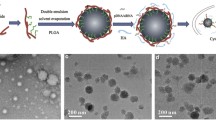Abstract
The strategies for tumor-specific expression of suicide genes and target tumor angiogenesis have been tested in tumors. However, the anti-tumor efficacy of the combination of these two strategies, particularly, delivering suicide gene and anti-angiogenesis agent by nanoparticles, has not yet been evaluated in colon carcinoma. We constructed a cassette to silence VEGF-A expression and express a fused yCDglyTK gene driven by tumor-specific promoter (shVEGF-CDTK). The DNA carrying shVEGF-CDTK was delivered into colon carcinoma cells by calcium phosphate nanoparticles (CPNPs). Cell proliferation was measured by MTT assay, and apoptosis was detected by flow cytometry. The anti-tumor effect of the combined cassette was tested in xenograft animal model. With 5-fluorocytosine (5-FC), CPNP-delivered shVEGF-CDTK DNA (CPNP-shVEGF-CDTK) showed high expression of fused yCDglyTK gene and effectively silenced VEGF-A expression in vitro and in vivo, which significantly inhibited colon carcinoma cell proliferation and induced apoptosis in vitro. With 5-FC, the systemic delivery of CPNP-shVEGF-CDTK significantly inhibited tumor growth in the colon carcinoma xenograft animal model. The combined cassette is obviously effective in inhibiting tumor cell proliferation and inducing apoptosis in vitro and tumor growth in vivo than the CPNP-shVEGF or CPNP-CDTK alone. The combination of VEGF-A-silencing and tumor-specific expression of suicide gene is an effective strategy for colon carcinoma treatment.





Similar content being viewed by others
References
Center MM, Jemal A, Smith RA, et al. Worldwide variations in colorectal cancer. CA Cancer J Clin. 2009;59:366–78.
Xu AG, Yu ZJ, Jiang B, et al. Colorectal cancer in Guangdong Province of China: a demographic and anatomic survey. World J Gastroenterol. 2010;16:960–5.
Ades S. Adjuvant chemotherapy for colon cancer in the elderly: moving from evidence to practice. Oncology. 2009;23:162–7.
Blagbrough IS, Zara C. Animal models for target diseases in gene therapy—using DNA and siRNA delivery strategies. Pharm Res. 2009;26:1–18.
Collins SA, Guinn BA, Harrison PT, et al. Viral vectors in cancer immunotherapy: which vector for which strategy? Curr Gene Ther. 2008;8:66–78.
Karmali PP, Chaudhuri A. Cationic liposomes as non-viral carriers of gene medicines: resolved issues, open questions, and future promises. Med Res Rev. 2007;27:696–722.
Kodama K, Katayama Y, Shoji Y, et al. The features and shortcomings for gene delivery of current non-viral carriers. Curr Med Chem. 2006;13:2155–61.
Hart SL. Multifunctional nanocomplexes for gene transfer and gene therapy. Cell Biol Toxicol. 2010;26:69–81.
Mintzer MA, Simanek EE. Nonviral vectors for gene delivery. Chem Rev. 2009;109:259–302.
Liu T, Tang A, Zhang G, et al. Calcium phosphate nanoparticles as a novel nonviral vector for efficient transfection of DNA in cancer gene therapy. Cancer Biother Radiopharm. 2005;20:141–9.
Khurana B, Goyal AK, Budhiraja A, et al. siRNA delivery using nanocarriers—an efficient tool for gene silencing. Curr Gene Ther. 2010;10:139–55.
Agrawal N, Dasaradhi PV, Mohmmed A, et al. RNA interference: biology, mechanism, and applications. Microbiol Mol Biol Rev. 2003;67:657–85.
Shinkaruk S, Bayle M, Laïn G, et al. Vascular endothelial cell growth factor (VEGF), an emerging target for cancer chemotherapy. Curr Med Chem Anticancer Agents. 2003;3:95–117.
Ellis LM, Hicklin DJ. VEGF-targeted therapy: mechanisms of anti-tumor activity. Nat Rev Cancer. 2008;8:579–91.
Yang Y, Bai Y, Xie G, et al. Efficient inhibition of non-small-cell lung cancer xenograft by systemic delivery of plasmid-encoding short-hairpin RNA targeting VEGF. Cancer Biother Radiopharm. 2010;25:65–73.
Zhang G, Liu T, Chen YH, et al. Tissue specific cytotoxicity of colon cancer cells mediated by nanoparticle-delivered suicide gene in vitro and in vivo. Clin Cancer Res. 2009;15:201–7.
Xia K, Liang D, Tang A, et al. A novel fusion suicide gene yeast CDglyTK plays a role in radio-gene therapy of nasopharyngeal carcinoma. Cancer Gene Ther. 2004;11:790–6.
Goldstein MJ, Mitchell EP. Carcinoembryonic antigen in the staging and follow-up of patients with colorectal cancer. Cancer Invest. 2005;23:338–51.
Liu T, Zhang G, Chen YH, et al. Tissue specific expression of suicide genes delivered by nanoparticles inhibits gastric carcinoma growth. Cancer Biol Ther. 2006;5:1683–90.
Liu T, Tang A, Zhang G, Chen Y, Zhang J, Peng S, et al. Calcium phosphate nanoparticles as a novel nonviral vector for efficient transfection of DNA in cancer gene therapy. Cancer Biother Radiopharm. 2005;20:141–9.
Zhang X, Kon T, Wang H, et al. Enhancement of hypoxia-induced tumor cell death in vitro and radiation therapy in vivo by use of small interfering RNA targeted to hypoxia-inducible factor-1alpha. Cancer Res. 2004;64:8139–42.
Bergers G, Benjamin LE. Tumorigenesis and the angiogenic switch. Nat Rev Cancer. 2003;3:401–10.
Hsu JY, Wakelee HA. Monoclonal antibodies targeting vascular endothelial growth factor: current status and future challenges in cancer therapy. BioDrugs. 2009;23:289–304.
Takahashi Y, Nishikawa M, Takakura Y. Nonviral vector-mediated RNA interference: its gene silencing characteristics and important factors to achieve RNAi-based gene therapy. Adv Drug Deliv Rev. 2009;61:760–6.
Maitra A. Calcium phosphate nanoparticles: second-generation nonviral vectors in gene therapy. Expert Rev Mol Diagn. 2005;5:893–905.
Acknowledgments
This work has been supported by the Chinese National Natural Science Foundation (grant no. 30800518) and the New Teachers of Doctor Fund Project of Ministry of Education (grant no. 200805331090).
Conflicts of interest
None.
Author information
Authors and Affiliations
Corresponding author
Rights and permissions
About this article
Cite this article
Leng, A., Yang, J., Liu, T. et al. Nanoparticle-delivered VEGF-silencing cassette and suicide gene expression cassettes inhibit colon carcinoma growth in vitro and in vivo. Tumor Biol. 32, 1103–1111 (2011). https://doi.org/10.1007/s13277-011-0210-5
Received:
Accepted:
Published:
Issue Date:
DOI: https://doi.org/10.1007/s13277-011-0210-5




